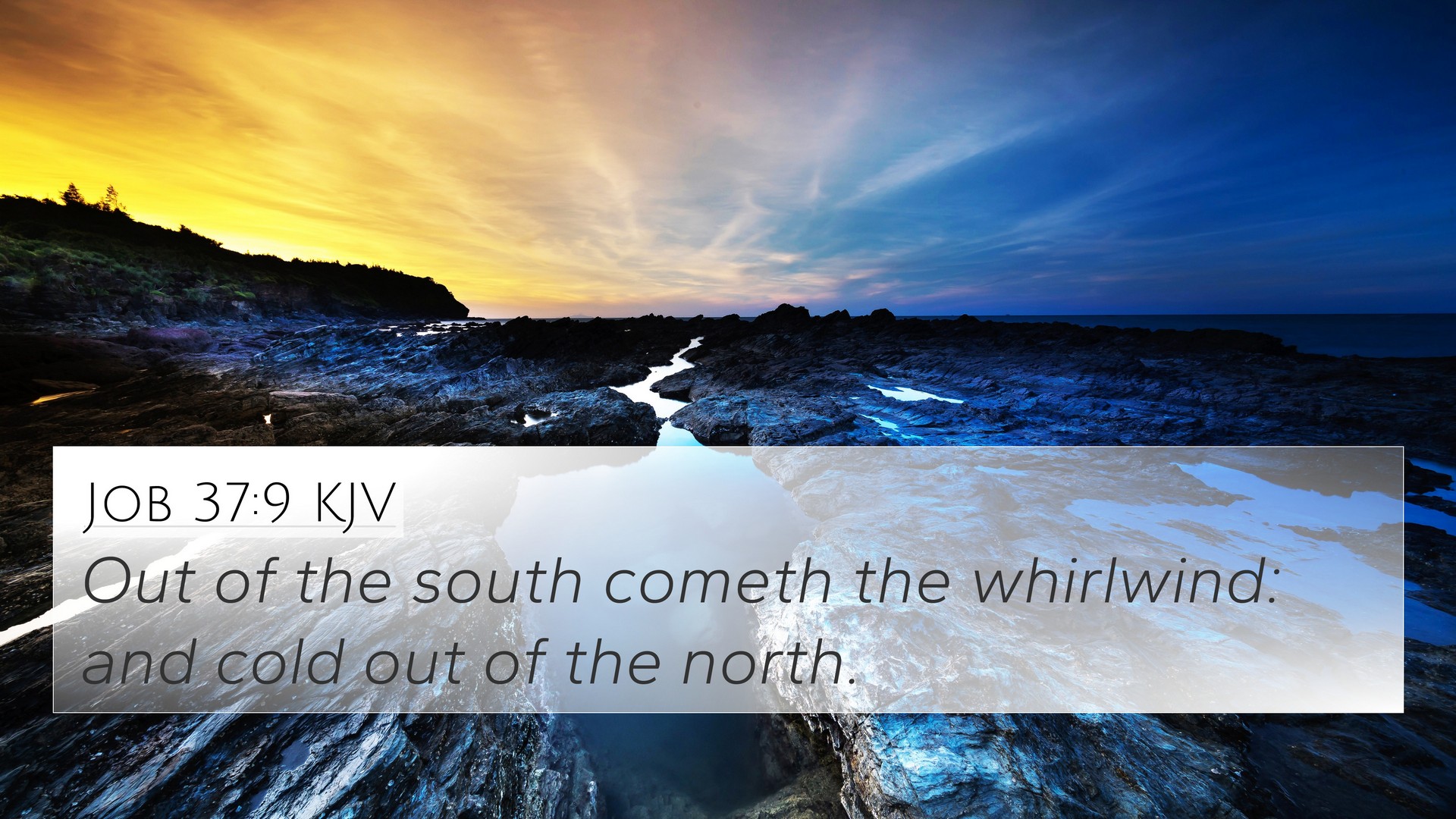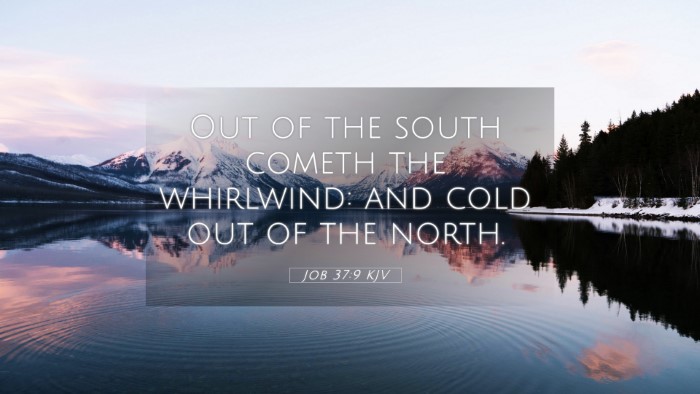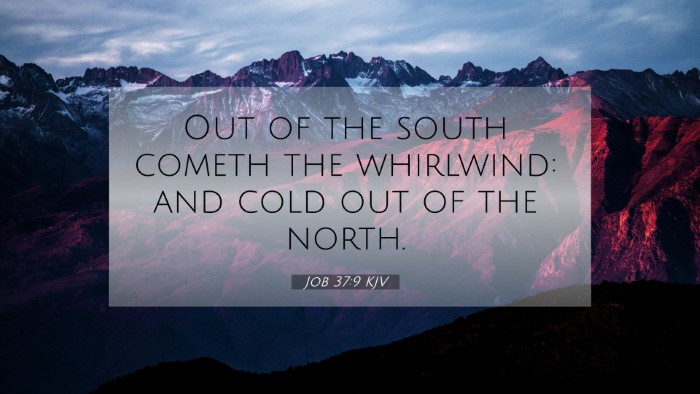Old Testament
Genesis Exodus Leviticus Numbers Deuteronomy Joshua Judges Ruth 1 Samuel 2 Samuel 1 Kings 2 Kings 1 Chronicles 2 Chronicles Ezra Nehemiah Esther Job Psalms Proverbs Ecclesiastes Song of Solomon Isaiah Jeremiah Lamentations Ezekiel Daniel Hosea Joel Amos Obadiah Jonah Micah Nahum Habakkuk Zephaniah Haggai Zechariah MalachiJob 37:9 Similar Verses
Job 37:9 Cross References
Out of the south cometh the whirlwind: and cold out of the north.
Uncover the Rich Themes and Topics of This Bible Verse
Listed below are the Bible themes associated with Job 37:9. We invite you to explore each theme to gain deeper insights into the Scriptures.
Job 37:9 Cross Reference Verses
This section features a detailed cross-reference designed to enrich your understanding of the Scriptures. Below, you will find carefully selected verses that echo the themes and teachings related to Job 37:9 KJV. Click on any image to explore detailed analyses of related Bible verses and uncover deeper theological insights.
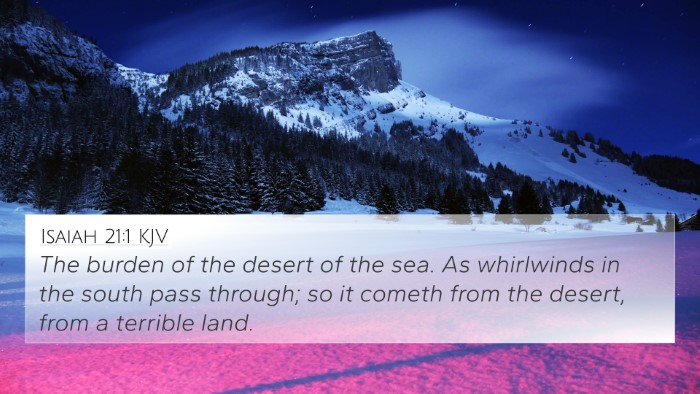
Isaiah 21:1 (KJV) »
The burden of the desert of the sea. As whirlwinds in the south pass through; so it cometh from the desert, from a terrible land.
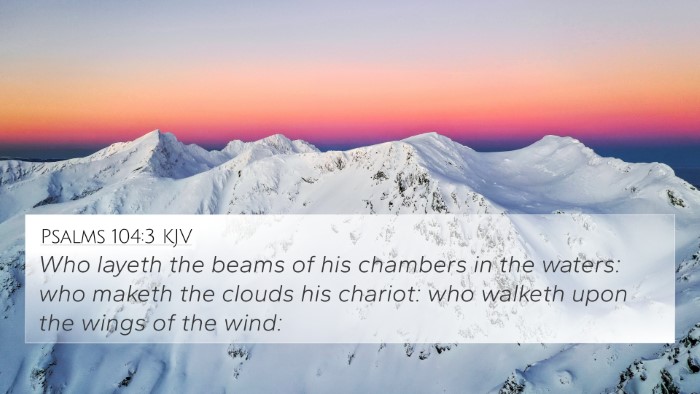
Psalms 104:3 (KJV) »
Who layeth the beams of his chambers in the waters: who maketh the clouds his chariot: who walketh upon the wings of the wind:
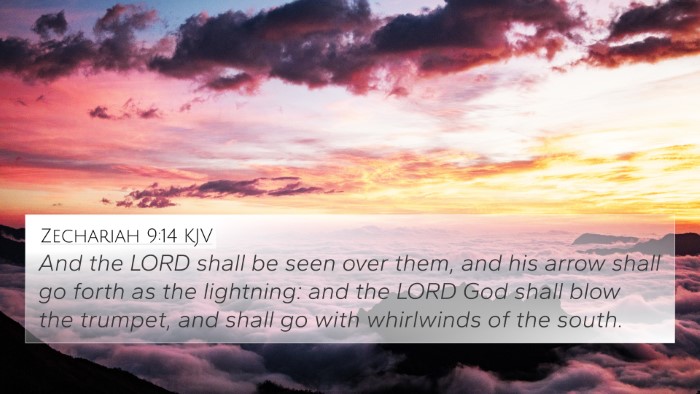
Zechariah 9:14 (KJV) »
And the LORD shall be seen over them, and his arrow shall go forth as the lightning: and the LORD God shall blow the trumpet, and shall go with whirlwinds of the south.
Job 37:9 Verse Analysis and Similar Verses
Understanding Job 37:9
Job 37:9 states: "Out of the South cometh the whirlwind: and cold out of the North." This verse captures the grandeur of God's creation and His sovereignty over nature, emphasizing the power and majesty of His works.
Summary of Insights
Various public domain commentaries provide valuable interpretations of this verse:
-
Matthew Henry:
Henry notes that this verse illustrates the mightiness of God's hand in the natural phenomena around us. The reference to the whirlwind symbolizes the tempestuous nature of storms and suggests God's control over the forces of nature. It serves as a reminder of God's omnipotence and the awe-inspiring display of His power in creation.
-
Albert Barnes:
Barnes elaborates on the imagery of the wind and its origins, interpreting the 'South' and 'North' as symbolic directions that signify divine activity. The description of natural elements is presented to highlight the majesty of God, and to signify that even the most tumultuous events in nature are under His complete authority.
-
Adam Clarke:
Clarke interprets the whirlwind as an emblematic representation of God’s voice, suggesting that storms can act as instruments through which God communicates His presence and power. He points out that both cold and heat come from different quarters of the earth, symbolizing the balance and control God holds over all elements.
Thematic Connections
This verse offers several thematic connections with other parts of the Bible that speak of God's control over nature and creation. Here are some biblical cross-references:
- Psalms 29:3-4: "The voice of the Lord is upon the waters: the God of glory thundereth: the Lord is upon many waters. The voice of the Lord is powerful; the voice of the Lord is full of majesty."
- Isaiah 40:22: "It is he that sitteth upon the circle of the earth, and the inhabitants thereof are as grasshoppers; that stretcheth out the heavens as a curtain, and spreadeth them out as a tent to dwell in."
- Matthew 8:26: "And he saith unto them, Why are ye fearful, O ye of little faith? Then he arose, and rebuked the winds and the sea; and there was a great calm."
- Job 38:1: "Then the Lord answered Job out of the whirlwind, and said..."
- Mark 4:39: "And he arose, and rebuked the wind, and said unto the sea, Peace, be still. And the wind ceased, and there was a great calm."
- Jeremiah 10:13: "When he uttereth his voice, there is a multitude of waters in the heavens; and he causeth the vapors to ascend from the ends of the earth; he maketh lightnings with rain, and bringeth forth the wind out of his treasures."
- Proverbs 30:4: "Who hath ascended up into heaven, or descended? Who hath gathered the wind in his fists? Who hath bound the waters in a garment? Who hath established all the ends of the earth? What is his name, and what is his son's name, if thou canst tell?"
Conclusion
The exploration of Job 37:9 through these commentaries reveals deep truths about God’s sovereignty, the majesty of His creation, and His power over nature. The emphasis on the whirlwind and cold winds signifies that every element of creation has a purpose and reflects the divine order of the universe. It reminds us that when we observe the forces of nature, we are witnessing the imposing power of God who governs all from the heavens.
Tools for Bible Cross-Referencing
For those interested in deeper study, several tools can facilitate exploring the links between biblical texts:
- Bible concordance
- Bible cross-reference guide
- Cross-reference Bible study materials
- Bible reference resources
- Bible chain references
How to Use Bible Cross-References
Using cross-references effectively involves:
- Identifying connections between Old and New Testament passages.
- Comparative studies demonstrating thematic links, such as between the Prophets and Apostolic teachings.
- Exploring cross-references that can support various sermon preparations.
Discovering Related Verses
To discover cross-references and related verses, the following methods can be employed:
- Look within your Bible for in-text references and notes.
- Utilize online tools or apps dedicated to Bible study, which offer features for tracking connections.
- Engage with community discussions around scriptural interpretations.
